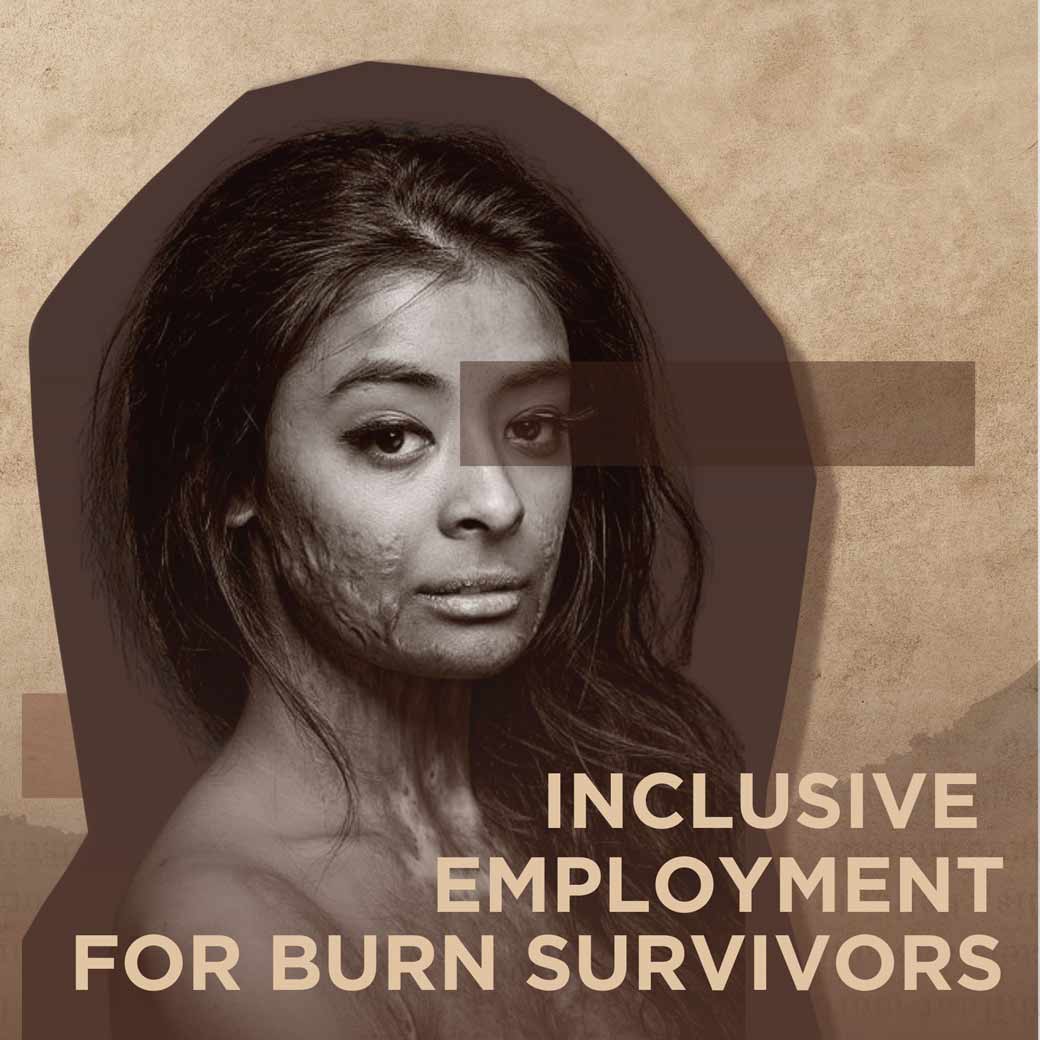Overview:
- Learn about disability inclusion in employment and how it relates to burn survivors
- Burn survivors also need to secure and nurture meaningful employment
- Inclusive employment is beneficial both for people with disabilities and for companies
- Designing an inclusive workplace is possible through simple steps
A Brief Overview of the Impact of Burn Injuries on Survivors
A burn injury can have a massive impact on a person’s self-esteem and confidence, and it is thought to be more commonplace in parts of the world where average income is lower. According to the World Health Organization, the majority of burn cases occur in low-and-middle-income countries. Children and women are at greater risk in domestic kitchens, while men are at greater risk in the workplace.
A burn injury refers to damage to the skin and deeper tissues caused by exposure to heat, electricity, chemicals, or radioactivity. Treatment for burns depends on the severity. Severe burns require immediate medical attention such as special wound care, surgery, prolonged hospitalization, and rehabilitation to aid recovery.

What Is Disability Inclusion in Employment?
While inclusivity is cited as a valued concept by almost all organizations today, there is still scope to initiate policies that support the employment of people with disabilities. Organizations that don’t create policies that aim to embrace inclusivity miss out on the talents that people with disabilities have to offer.
Disability inclusion goes beyond simply filling up a quota, or inviting people with disability to do more. Instead, it is a deliberate practice that ensures people with disabilities have equal access to employment opportunities and are valued, respected, and welcomed to fully participate in their careers. It requires employers to be more understanding, empathetic, transparent, and supportive of those with disabilities so they are not sole advocates for inclusion at work.
Inclusive employment helps integrate burn survivors into society. Being part of a healthy workplace provides a sense of purpose and accomplishment which in turn leads to a more positive self-image. Regular interaction with colleagues and customers helps foster social and communication skills, encourages network-building, and helps reduce feelings of isolation.
Through their presence and active participation in the workforce, survivors challenge societal misconceptions and the stigma associated with disability.
From Injury to Workplace: The Challenges Faced by Burn Survivors at Work
A study on Employment after Burn Injury shows that joining the workplace is one of the most critical yet challenging obstacles survivors face in their journey of rehabilitation. These obstacles may be related to the severity of the injury which creates functional limitations, as well as psychosocial issues such as anxiety, depression, and post-traumatic stress. Moreover, due to the depth of injury, survivors may carry scars on exposed body areas that gain “labels” or are reacted to differently by society.
Discrimination in the workplace may come from employers and colleagues. Some employers may refuse to promote employees because of their disability, or pay them less than their counterparts. Some colleagues may ask inappropriate questions, have a tendency to stare or react in an extreme manner, whisper or gossip, or show pity.
Vocational rehabilitation and employment support services are helpful resources that can assist burn survivors in acquiring the skills, training, and support their need to secure and nurture employment opportunities. Unfortunately, there is sometimes limited access to them, and burn survivors can’t always secure such support facilities.
Benefits of Inclusive Employment of Burn Survivors
Inclusive employment has multiple benefits not only for burn survivors but also for the organization.
Wider recruitment pool and greater talent
Actively seeking to hire inclusively opens up opportunities to hire people with unique skillsets, experiences, and perspectives that can enrich the atmosphere of the organization. Having people with disabilities across departments can make sure products and services are also inclusive.
Productivity and creativity
An inclusive organization instills a sense of belonging in all workers. When workers feel respected and supported, morale increases and their creativity and productivity improve. Work environments that are more inclusive of people with disabilities commonly notice a surge in productivity.
Increased employee retention rates
Companies want good employees to stay. One benefit of inclusivity can be a higher staff retention rate and lower turnover rates than companies without inclusivity in employment.
Customer brand loyalty
Some customers purposely seek out companies that align with their values, and inclusivity may be one of those values. Furthermore, people with disabilities are customers who are more likely to take their custom to a brand that sees and includes them. Companies that openly showcase inclusivity initiatives can reap the benefits of brand loyalty.
Reputation building
Earning and maintaining a positive public image is challenging for new and established companies. A damaged brand reputation is costly to repair. Consistent publicity can help strengthen your brand by association, and inclusivity as an employment principle can showcase a company’s values.

Designing an Inclusive Workplace: What are the Interventions or Best Practices?
Inclusivity in hiring
Companies should create and develop a recruitment strategy that outlines their commitment to diversity and inclusivity. The hiring teams should be unbiased and promote transparency in the hiring process by ensuring that skills and qualifications are valued, and not physical appearance. Targeted recruitment initiatives can also help support burn survivors in joining the workforce.
Reasonable accommodation
When an employee discloses a disability to an employer, it is important the employer accommodates the individual’s needs. The employer and employee should continue to communicate to make any further adjustments, such as:
- A modified work schedule
- Limits on physical strain
- Adaptive equipment for workplace tasks
- Flexible work schedules that accommodate medical appointments and outpatient physical therapy
Vocational rehabilitation support
Burn survivors who gain access to vocational rehabilitation may be given support to overcome the barriers to employment after injury:
-
- Analysis to determine whether potential jobs are suitable for the burn survivor (review tasks, cognitive, physical, and social expectations)
- Develop plans for employment-related goals
- Assess skills, limitations, health needs, and personal concerns
- Negotiate trial periods with potential employers to determine if the job is a proper fit, and highlight any specific needs
Creating awareness and building sensitization
Companies should ensure that burn survivors feel welcomed and respected in their place of work. Tackling discrimination and stigma starts with providing disability sensitivity training for employers and employees. Organizing awareness days in the office, facilitating workshops, and providing key learning resources for employees are ways of creating awareness. Encouraging burn survivors to share their experiences about living with a disability can also help mitigate misconceptions and stigma in the workplace. It also gives survivors a platform to advocate for awareness both at work and also in their broader community.
Supporting Burn Survivors Globally
Partnering with burn survivor advocacy and support groups to raise public awareness is a positive step toward ensuring inclusivity in an organization. The Grossman Burn Foundation is the philanthropic arm of the Grossman Burn Centers, a pioneer in international burn treatment facilities. The foundation works to provide burn prevention outreach and seeks to collaborate with local agencies working in the public safety, education, and healthcare sectors.
Recently, Grossman Burn Foundation partnered with Girl Power USA, a nonprofit promoting global social impact initiatives. Among Girl Power USA’s projects, Sheroes Hangout café in India offers employment to acid attack survivors. The survivors run the café with enthusiasm and rebuild their lives one step and a time. Sheroes is a symbol of hope. Through continued support, the Sheroes Hangout café reaches more people who listen to the stories of the women and patronize the business.
The importance of inclusivity in employment for burn survivors cannot be understated. We encourage employers to take proactive steps toward promoting inclusivity in their organizations. Join us in promoting inclusivity in the workplace. Together we can build an equitable society where anyone and everyone can put in their very best.
Conclusion:
The inclusion of burn survivors in the workplace is not only beneficial both for burn survivors and companies alike but it can be done by taking simple steps. Inclusivity in employment is essential to achieve equity in the workplace.



